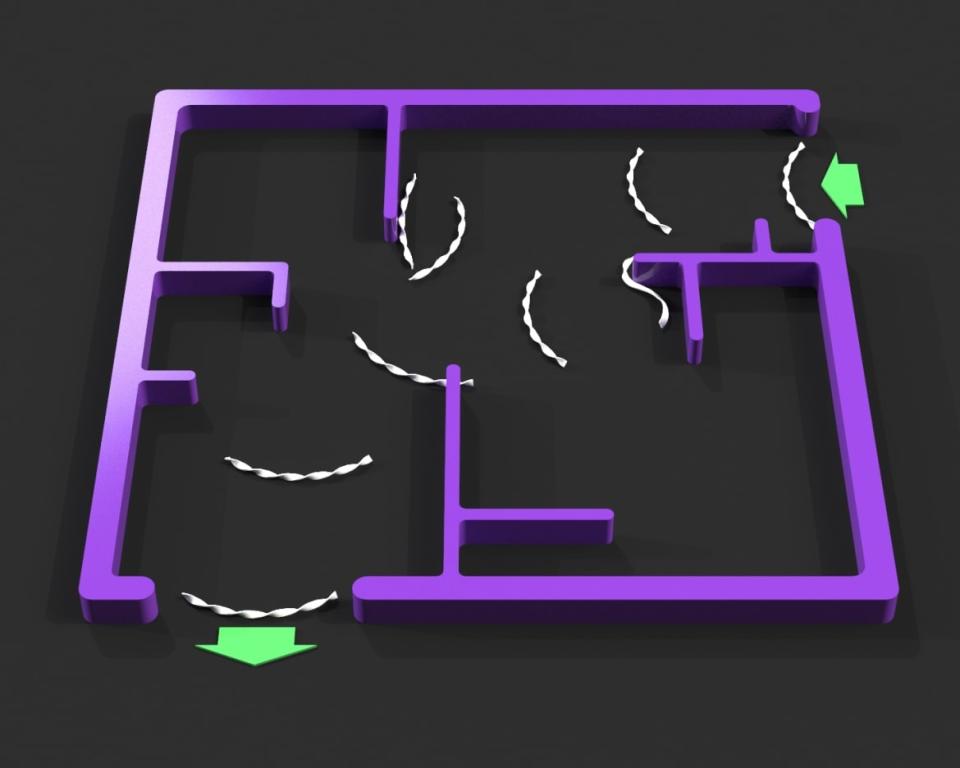Watch This Noodle-Shaped Robot Autonomously Escape a Maze

You might not look at pasta the same way after seeing this robot.
Researchers at North Carolina State University and the University of Pennsylvania have created a rotini-shaped robot that can tumble through a maze without any help or guidance from a computer or human being. In a paper published Monday in the journal PNAS, the researchers made the robot out of a plasticky material shaped into a translucent corkscrew, able to navigate by interacting with the barriers of a maze and bouncing off of them like a Roomba does when it encounters a wall or an obstacle.
“These soft robots demonstrate a concept called ‘physical intelligence,’ meaning that structural design and smart materials are what allow the soft robot to navigate various situations, as opposed to computational intelligence,” Jie Yin, a mechanical engineer at North Carolina State University and co-author of the new paper, said in a press release.
“This has been done before with smooth-sided rods, but that shape has a drawback—when it encounters an object, it simply spins in place,” explained Yin. “The soft robot we’ve made in a twisted ribbon shape is capable of negotiating these obstacles with no human or computer intervention whatsoever.”
The robot is made of liquid crystal elastomers, rubbery chemical compounds that contort when exposed to high temperatures. When placed on a surface of 131 degrees Fahrenheit, the “belly” of the robot contracts while its top half exposed to the cool air does not. This difference makes the robot roll around like a possessed Twizzler (honestly, check out the video below).
But the ingenious part that allows this blind robot to maneuver around boundaries without eyesight is a phenomenon the researchers describe as a “snap.” When the rotini-bot rushes body-long into the hedges of a maze, it rotates slightly to get around. However, if the robot’s center makes contact with the hedge, it “snaps,” deforming and releasing all this pent-up energy that allows it to bounce away (like the force released on a compressed spring). Snaps can happen all along the length of the robot but are most powerful when at the center.
Yin and his colleagues found their corkscrew robot was not too shabby at navigating not only some simple mazes, but a hot car roof, a bed of loose sand, and, weirdly enough, a charcoal grill.
While the researchers hope to improve the robot’s design and have its mobility less dependent on high temperatures, they see a potential for soft-bodied bots that don’t need brains, per se, but can still interact intelligently with their environment without guidance from humans or computer navigation systems.
“This is interesting, and fun to look at,” said Yin. “But more importantly, it provides new insights into how we can design soft robots that are capable of harvesting heat energy from natural environments and autonomously negotiating complex, unstructured settings such as roads and harsh deserts.”

Researchers have developed soft robots that are capable of navigating complex environments, such as mazes, without input from humans or computer software. The soft robots are made of liquid crystal elastomers in the shape of a twisted ribbon, resembling translucent rotini.
Got a tip? Send it to The Daily Beast here
Get the Daily Beast's biggest scoops and scandals delivered right to your inbox. Sign up now.
Stay informed and gain unlimited access to the Daily Beast's unmatched reporting. Subscribe now.

